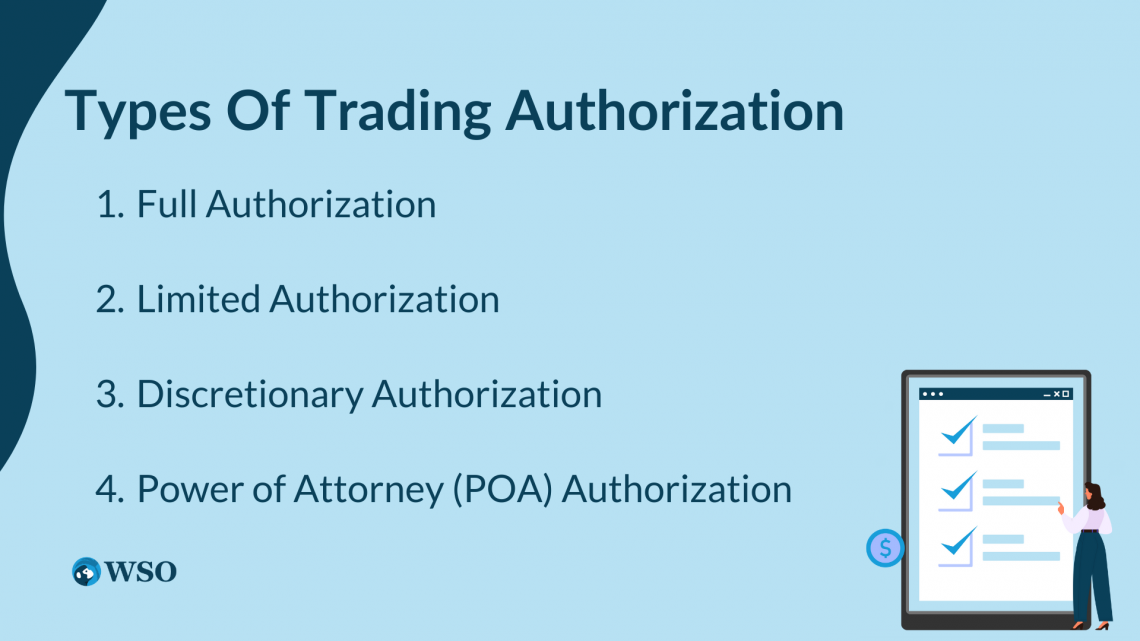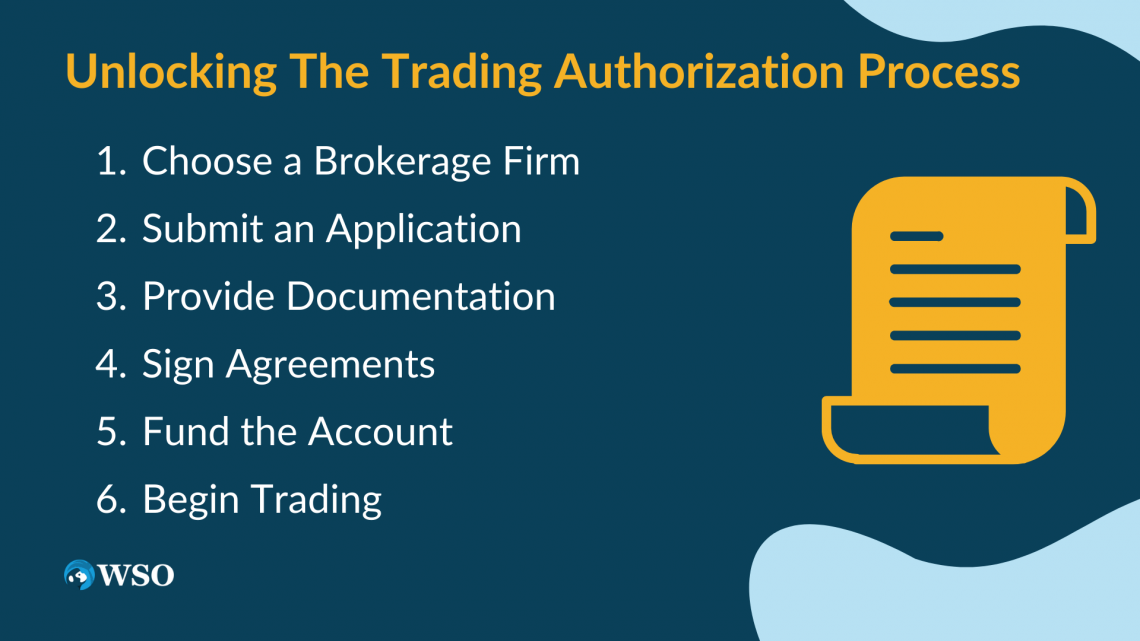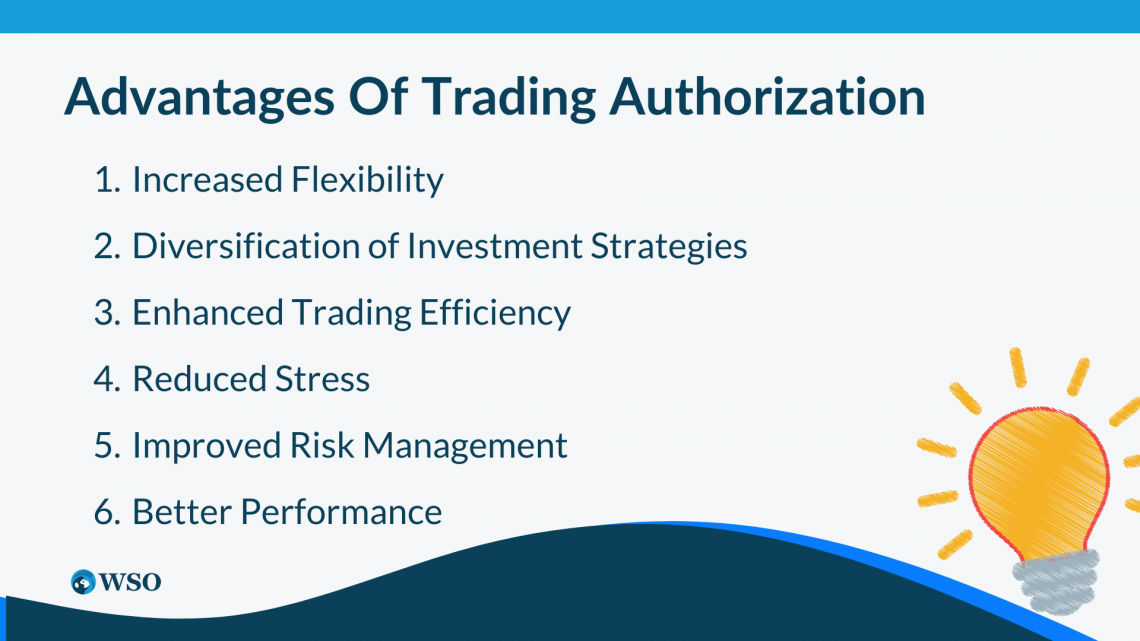Trading Authorization
It refers to the procedure of granting an individual or entity the legal authority to make trades on behalf of another party
Trading authorization refers to the procedure of granting an individual or entity the legal authority to make trades on behalf of another party. This type of permission is frequently used in diverse financial markets, including stocks, bonds, options, or futures.

It is a legal document allowing a certain individual or establishment to make trades on behalf of another party. This authorization can be granted for many reasons, such as:
- Convenience
- Delegation of responsibilities
- Risk management
The process of obtaining a trading license typically involves completing paperwork, submitting documentation, and receiving approval from the appropriate authorities. There are different types of trading consent available to investors and traders.
Limited authorization moderates the types of trades that can be made and the amount of funds that can be invested. A discretionary license allows someone to make trades on behalf of another party but with the added flexibility to make independent decisions.
Power of Attorney (POA) authorization is a valid document that grants someone the right to make decisions on behalf of another party.

Trading permission offers several advantages to investors and traders. It allows for greater flexibility in trading, enabling a person or structure to execute trades on behalf of another party.
This flexibility can be extremely useful in situations where the principal trader is unavailable or unable to make trades. Trading consent also facilitates the delegation of trading responsibilities, enabling investors and traders to focus on other aspects of their investment strategy.
However, trading authorization is not without its risks and concerns. There is always the potential for unauthorized trading, where an individual or entity trades without proper authorization or approval.

Authorized traders also carry liability for losses incurred by the party they are trading on behalf of. Therefore, it is crucial to set clear trading guidelines and risk parameters to ensure that authorized traders operate within the appropriate boundaries.
The remainder of this article will traverse the various types of trading permission, the process of obtaining authorization, the benefits and risks of trading authorization, best practices, and more.
It is indispensable to recognize the risks and concerns associated with trading authorization and take proper precautions to mitigate them.
Key Takeaways
- Trading authorization refers to the procedure of granting an individual or entity the legal authority to make trades on behalf of another party.
- There are different types of trading consent available to investors and traders.
- The process of acquiring trading certification can be complex and time-consuming.
- Full authorization is the most comprehensive type of trading authorization available.
- With limited authorization, the authorized trader can only make trades within the specific guidelines the primary trader sets.
- Discretionary authorization is similar to limited authorization, but it gives authorized traders the added flexibility to make trading decisions on their own.
- With POA authorization, the authorized trader can make financial and non-financial decisions on behalf of the primary trader.
Types Of Trading Authorization
There are several types of trading licenses available to investors and traders. Each type of authorization has its unique advantages and restrictions. Below are the most common types of trading authorization:

1. Full Authorization
Full authorization is the most comprehensive type of trading authorization available. This type of document accords an individual or entity with the ability to make trades on behalf of another party without any limitations or restrictions.
The trader has absolute control over the trading activities of the company they are trading in the name of. This type of authorization is typically used when the primary trader is unavailable or unable to make trades.
2. Limited Authorization
This is the strictest license possible. It fixes restrictions on the amount of money and the type of transactions. With limited authorization, the authorized trader can only make trades within the specific guidelines the primary trader sets.
Note
Limited Authorization is often used when the primary trader wants to maintain some control over the trading activities but needs assistance with executing trades.
3. Discretionary Authorization
Unlike limited authorization, discretionary authorization allows the authorized trader to make trading decisions.
With discretionary authorization, the authorized trader can make trades without seeking approval from the primary trader for each trade. However, the primary trader can still set guidelines and restrictions on the types of trades that can be made.
4. Power of Attorney (POA) Authorization
POA permission is a legal document that grants someone the power to make decisions on behalf of another party. This type of authorization is often used when the primary trader cannot make decisions due to incapacity or illness.
Note
With POA authorization, the authorized trader can make financial and non-financial decisions on behalf of the primary trader.
Each type of trading certification has its unique advantages and disadvantages. Full authorization offers the most flexibility and control over trading activities, but it also carries the highest level of risk.
Limited authorization provides some level of control over trading activities while still allowing for assistance with executing trades. Discretionary authorization offers the most flexibility for the authorized trader but may result in higher risk if the trader is improperly supervised.
POA authorization is typically used when the primary trader cannot make decisions due to incapacity or illness and carries a high level of responsibility for the authorized trader.
Note
It is essential to carefully consider the advantages and risks before selecting an authorization type.
Unlocking the Trading Authorization Process
Obtaining a trading permit can be an intricate procedure requiring meticulous strategizing and readiness. Here are the steps required to obtain trading authorization:

1. Choose a Brokerage Firm
The first step in acquiring trading certification is to select a brokerage firm that offers the type of trading services you require. Their services, the fees, and the types of accounts they support can be very different. Researching and comparing several firms is essential to find one that fits your needs.
2. Submit an Application
Once you have nominated a brokerage firm, the next step is to submit an application for trading permission. The process is straightforward and involves providing your personal particulars (identity, residence, national identification number, and professional details).
Additionally, the brokerage firm will also ask for information about your:
- Investment goals
- Risk tolerance
- Investment experience
3. Provide Documentation
The brokerage firm will require you to supply documentation to verify your identity and financial information. They may also ask for additional documentation, depending on the trading authorization you seek.
Note
Documentation may include a government-issued ID, tax returns, bank statements, and investment account statements.
4. Sign Agreements
After submitting the application and providing documentation, the next step is to sign agreements with the brokerage firm. These accords will outline the terms and conditions of the trading license, including:
- The fees charged
- The types of trades that can be made
- Any restrictions that apply
5. Fund the Account
Once the agreements have been signed, you should fund the account. This involves transferring funds into the account from a bank account or other investment account.
Note
The business organization will give you instructions on how to transfer funds.
6. Begin Trading
Once the account has been funded, the ultimate step is to start trading. The authorized trader can place trades through the brokerage firm's trading platform or by contacting a representative directly.
Getting trading authorization involves selecting a brokerage firm, submitting an application, providing documentation, signing agreements, funding the account, and beginning trading.
The procedure is time-consuming and complex, but it is indispensable to guarantee that the authorized trader operates within the appropriate boundaries and that the primary trader's interests are protected.
Proper documentation and clear guidelines are critical to establishing a successful trading relationship between authorized and primary traders.
Advantages Of Trading Authorization
The trading license provides several benefits for both primary traders and authorized traders:

1. Increased Flexibility
The trading license offers primary traders increased flexibility by delegating trading responsibilities to authorized traders. This can be particularly useful when the primary trader is unavailable or unable to make trades due to other commitments.
By authorizing another person to trade on their behalf, primary traders can ensure that their investment portfolios continue to perform well, even when they cannot manage them personally.
2. Diversification of Investment Strategies
By authorizing traders who specialize in different markets or have expertise in specific asset classes, primary traders can take advantage of investment opportunities they may not have been aware of or had access to previously, leading to potentially higher returns.
3. Enhanced Trading Efficiency
Authorized traders can help primary traders trade more efficiently by monitoring market conditions and executing trades promptly.
Note
By closely following market trends and reacting quickly to opportunities, authorized traders can help primary traders take advantage of market conditions and make trades at the most reasonable times.
4. Reduced Stress
Delegating trading responsibilities to authorized traders can reduce the stress and anxiety of managing investment portfolios.
Primary traders can trust authorized traders to manage their investments competently, allowing them to focus on other aspects of their lives without worrying about the performance of their portfolios.
5. Improved Risk Management
Trading authorization can help primary traders manage risk more effectively.
Note
By authorizing traders with experience and expertise in risk management, primary traders can minimize the risk of losing money and potentially maximize returns.
6. Better Performance
With specialized skills and insights, authorized traders can contribute to improved portfolio performance, potentially generating higher returns for primary traders.
By working together, primary and authorized traders can build strong trading relationships that benefit both parties in the long term.
Trading Authorization Risks And Concerns
While a trading license offers several advantages, it is not without its risks and concerns. Let us focus on six risks and concerns associated with trading authorization:

1. Loss of Control
By delegating trading responsibilities to authorized traders, primary traders may lose control over their investment portfolios. Authorized traders may make trades that do not align with the primary trader's investment goals or risk tolerance, potentially leading to losses or missed opportunities.
2. Unauthorized Trading
Unauthorized trading is a significant concern associated with trading authorization. Unauthorized trading occurs when an authorized trader trades outside the primary trader's guidelines or without permission.
This can lead to substantial losses and damage the primary trader's trust in the authorized trader and the brokerage firm.
3. Conflicts of Interest
Conflicts of interest are another risk associated with trading licenses. Authorized traders may have investment goals and interests that conflict with the primary trader's goals, potentially leading to unethical or illegal behavior.
Note
It is essential for primary traders to thoroughly vet authorized traders and brokerage firms to ensure that there are no conflicts of interest.
4. Security Concerns
Trading certification involves sharing sensitive personal and financial information with authorized traders and brokerage firms. This information must be kept secure and confidential to prevent identity theft, fraud, or other security breaches.
It is essential for primary traders to choose brokerage firms with strong security protocols and to monitor their accounts for any suspicious activity regularly.
5. Regulatory Compliance
A trading license is influenced by regulatory compliance requirements such as Know-Your-Customer or Anti-Money Laundering regulations.
Note
Failure to comply with these regulations can result in fines, legal penalties, and reputational damage for both primary and authorized traders.
6. Fees and Commissions
Trading authorization involves additional fees and commissions, impacting investment returns. Primary traders should carefully review the fees and commissions associated with trading authorization and factor them into their investment strategies and portfolio performance.
In conclusion, while trading certification offers several benefits, it is not without its risks and concerns.
Some of the key risks and concerns associated with trading authorization are:
- Loss of control
- Unauthorized trading
- Conflicts of interest
- Security concerns
- Regulatory compliance
- Fees and commissions
Primary traders should carefully weigh the advantages and disadvantages of trading authorization and work closely with authorized traders and brokerage firms to manage these risks effectively.




or Want to Sign up with your social account?